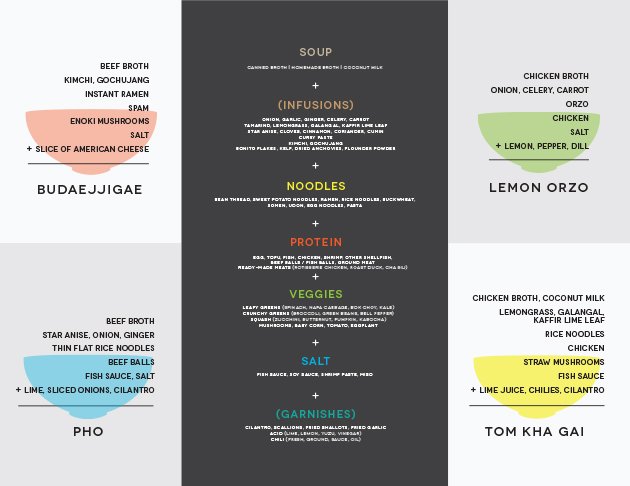Quick noodle soups have become a default meal of mine. When I started working from home a number of years ago, I found myself with a bit more time and flexibility, and so I started falling into the luxurious habit of making myself a hot lunch in the middle of the day (or mid-morning, or late afternoon, or whenever, really). And thanks to my Southeast Asian blood, what I seemed to crave most of the time was a steaming hot bowl of noodle soup (which I can eat yearround, even in the dead of summer). Obviously, the traditional noodle soups are too involved to whip up for lunch, and while instant noodles are fast, they are anything but healthy. But what I realized was that if I was willing to open up a bag of noodles and put a pot of water on the stove, it wouldn’t take much more effort to make a simple noodle soup from scratch. Actually, it wouldn’t take much longer than waiting for water to boil.
Here is the basic formula I follow :Â broth (+ infusions) + noodles + meat / veggies (+ garnishes).
Most of the time my quick noodle soups come together from leftovers, and often it starts with leftover chicken stock from poaching chicken, which I keep frozen in small portions. But you can use whatever you have on hand. If you keep just a few common kitchen staples, like a can of broth, some dried noodles (even if it happens to be ramen — just throw out the seasoning packets), an egg, and maybe some fresh or frozen vegetables, you have the makings of a noodle soup. If you cook more regularly, you may also have some onion or garlic on hand, some dried spices, and maybe even some broth-infusing elements like bonito flakes, dried shiitake mushrooms, or dried scallops, in which case you’re well on your way to a gourmet meal. Depending on how much time, energy, or ingredients you have, you can keep it really simple or take a few extra steps when you’re able to. This meal works just as well for a weeknight dinner, when you want something filling and balanced without too much effort.
To give you an idea of some noodle soup combinations that can be generated from this basic formula, Becca kindly put together a chart and some recipe flashcards for me, which you can see above. If you scroll to the end of this post, you’ll find a link to download this to print and cut up if you wish. But here is the center chart in more readable size:
And here are some additional tips and ideas…
– Vary the herbs, spices, or seasonings to create noodle soups inspired by some of your favorite cuisines. For example, start with kimchi and gochujang, and you have the beginnings of a Korean budaejjigae. Infuse some coconut milk with galangal, lemongrass, and kaffir lime leaf, and you’re on your way to a Thai tom kha gai. Neither of those are traditionally served as noodle soups, but they can be adapted to work that way.
– Here is the key to making noodle soups quick: find a noodle that will not require a separate pot. I am a huge fan of bean thread noodles (also called glass noodles or cellophane noodles), because they not only cook quickly but, more importantly, can be cooked directly in the same pot as the soup since they are not as starchy and will not cloud up the broth. You might even call bean thread noodles my secret to making noodle soup with no effort. Put them in the broth at the beginning, and by the time the liquid comes up to a boil, the noodles will almost be done. They will even absorb the broth and take on flavor, and for that reason it’s a good idea to salt the broth at the start.
– Instant noodles (aka, ramen) can also be used, since they’re meant to be cooked directly in the “soup,” though I actually do parboil my instant ramen separately to get rid of some of the wax and grease. Just toss out the seasoning packets since you’ll be creating your own soup. Instant ramen has such a bad reputation in the US, where it’s mostly considered cheap college student food. But in Asia, instant ramen comes in many, many varieties, and some of them are quite good! Some instant noodles actually use rice noodles, which cook up quickly and are not flash-fried like the instant wheat ramen noodles are.
– Most other noodles, particularly Asian noodles, require a separate pot of water. They should be cooked until just done and then rinsed in a sieve under cold water. I realize this is not what’s recommended for pasta, which requires some starch to help the sauce cling better. But when you’re serving noodles in broth, it is better to rinse off the excess starch in cold water so that (1) it stops the cooking process and gives your noodles a nice firm bite; (2) the excess starch does not cloud up your broth, muddying the flavor and texture; and (3) the noodles will not stick together and therefore will offer a much cleaner, less-goopy, more-satisfying texture when you put them in hot broth (otherwise you kind of just get a mouthful of starchy liquid rather than being able to taste noodles and broth distinctly).
– Pasta can work here too, even though the idea of noodle soup seems to point more toward Asian cuisines. Egg noodles are an obvious choice (as in chicken noodle soup), but there’s also vermicelli or tagliatelle, as well as orzo (which is similar to rice). My dad frequently uses star pasta mixed with ground beef to create a type of Vietnamese “congee” that is served as the last course in the Vietnamese 7 courses of beef. Hong Kong diner macaroni soup also comes to mind — try it with strips of ham or, as my dad often does, with ground pork. (See note on ground meat below.)
– When it comes to protein, eggs are very convenient for noodle soups. You can try cooking them in various ways, like poaching straight in the broth, soft- or hard-boiling them separately (if you’re already using a separate pot to cook noodles, cook the egg in it too), or whisking and then streaming them into the broth like in egg-drop soup.
– Don’t underestimate tofu. There’s a wide range in types of tofu, from soft silken tofu that breaks up in the broth, to denser types that holds its shape, to convenient frozen tofu puffs that are often included in noodle soups like laksa or bun rieu. You can also just freeze regular tofu (especially if you find yourself unable to finish it in a few days), which causes it to take on a spongey texture that is perfect for absorbing broth!
– Ground meat is another option and something my dad frequently uses in soups. His method is to pour a bit of the hot broth into a bowl with the raw ground meat, stir up the meat to separate it, and then pour all of this back into the simmering broth. This keeps the ground meat loose in the soup and is a really easy alternative to meatballs, though of course you could also just drop clumps of seasoned ground meat into the stock.
– Lastly, you can always pick up some ready-made protein on your way home, like rotisserie chicken or Cantonese roast duck or cha siu. A bowl of yellow egg noodles in chicken broth, topped with roast duck and some gai lan (Chinese broccoli) is a meal worthy of a Hong-Kong diner. Sprinkle some dried flounder powder into the broth, and you might even convince yourself you’re at Mak’s Noodle. :)
– There are so many rich, deeply flavored, even funky fermented ingredients you can use to salt your broth. Be adventurous. Try melting some fermented bean curd into the stock to create a creamy soup (my dad makes an excellent lamb hot pot with fermented bean curd as a base). Add some shrimp paste to a tomato- and pork-based broth, and you have the semblance of bun rieu or khanom jeen nam ngiaw.
– For me, this is what elevates the humblest bowl of soup and noodles. Some days, I could have nothing more than a can of chicken broth and some bean thread noodles. But then I top that off with thinly sliced scallions, a few sprigs of cilantro, fried shallots (which you can also buy dried with a long shelf-life, by the way), some sesame oil, and a dab of Chiu Chow Chili Oil — and it feels like a pretty special meal. Whatever it is that makes a dish for you — whether it’s the perfect chili sauce or a dash of your favorite seasoning — keep it on hand to turn simple meals into something satisfying.
Do you have a favorite noodle soup combination? Please share it in the comments! I’d love to gather more ideas for quick meal options. :)
Click on the picture below for the printable PDF.

















Connect with us